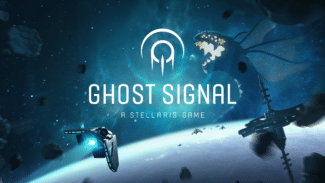Ghost Signal: A Stellaris Game brings the hit Paradox series to VR through an action roguelite spin-off. Available now on Quest 2, here’s our full review.
The latest title from developers Fast Travel Games, Ghost Signal is a new VR spin-off from Paradox Interactive’s grand strategy game Stellaris. Despite both titles sharing the same universe, familiarity with Stellaris isn’t required, and I found Ghost Signal perfectly accessible for series newcomers. Commanding a spaceship called the Aurora, you’re tasked with investigating the ancient and eponymous Ghost Signal. What follows is entirely different from its grand strategy predecessor and pursuing an original premise was a sensible call by Fast Travel Games.

Each level takes place inside a diorama-style environment from a third-person perspective. Enemies usually have two health bars for shields (blue) and the hull (red), requiring you to swap between Aurora’s three primary weapons on the back of your dominant hands. Lasers are effective against shields, blasters deal better hull damage, and both automatically recharge. Missiles tear through both but ammo refills are sparse, so use them wisely. If the Aurora takes damage once its shields deplete, this can’t usually be fixed until you visit the Tinkerers, merchants who often appear before boss battles.
Each session of Ghost Signal will see you begin a run through a path of levels. Because each playthrough is procedurally generated, two runs will always differ despite sharing similarities. There are three major boss fights and between each you can choose between multiple paths to advance. Along the way, you’ll earn EXP and ‘scraps’, the local currency dropped by destroyed enemy ships.
Low-risk routes with standard fights might seem sensible, but riskier options like elite battles provide components that improve Aurora’s capabilities. Decoy Drones add new distractions for enemies, for example, while Freeze Rays decrease a target’s movement speed when hit by lasers. Each component is upgradeable for 200 scraps.
There’s also the gamble of creature events, which can be hostile or friendly, alongside other events like choosing sides in a battle. One event type sees you investigating planets, which will award better components if you keep exploring. However, going further also risks obtaining defects with negative consequences, such as dropped scraps disappearing after three seconds. Other events can also inflict these defects upon you, and only Tinkerers can remove them.

All of these elements create a nice risk vs. reward mentality in Ghost Signal, which helps each run feel fresh. Encounters vary considerably and there’s good variety between enemies. Some will try directly ramming your ship in a head-on collision to deal significant damage, whereas larger battleships often release smaller units. While new enemies appear during the later stages of a run, it’s hard not to notice them using similar tactics.
Unfortunately, there’s no in-game suspend function to let you stop mid-run and return. This wouldn’t need to be a full save feature that allows you to “save scum” your way to victory, but a system akin to games like Hades or Returnal, which allow temporary saves that are deleted immediately upon use. You can get around this by putting your headset into sleep mode and returning later, but you’ll need to be careful with the headset’s battery life.
Overall, there’s plenty to consider but Ghost Signal is always manageable. It’s highly polished, streamlined and easy to understand, which is helped by a slick UI and some of the best visuals I’ve encountered on Quest 2. What initially felt challenging soon became natural and it wasn’t long before I became invested, feeling encouraged to keep going. Reaching the end feels incredibly satisfying, amplified by a tough final fight. I averaged around 35-40 minutes per successful run, though your mileage may vary depending on your chosen paths.

Death takes you back to square one with no components or scraps. Only EXP carries over, used for purchasing permanent Aurora upgrades like improved health and weapons, alongside a few cosmetic skins. Securing victory awards a key for accessing some intriguing lore, and the story advances upon completing further runs. Like most roguelites, Ghost Signal’s journey doesn’t end at the finish line, as your first victory also unlocks a series of gameplay modifiers. Reminiscent of Hades’ Pacts of Punishment, this lets you boost individual aspects of the difficulty, such as increased enemy shields, in exchange for greater rewards like more EXP. It’s an excellent option for anyone seeking a challenge.
There’s more to do beyond the main campaign. If you fancy putting your skills to the test, the ‘Daily Journey’ mode equips every player with a pre-determined set of components and a defined map. You can still choose which route to take but everyone has the same options, awarding points for hitting criteria like completing the run or taking on elite battles. Your score is then uploaded to online leaderboards, and while traditional multiplayer mode would not work in Ghost Signal, this brings an enjoyable competitive element to the game.
If you’re after something different, Ghost Signal also includes hand tracking support. Turning your hands palm-up lets you access menus, dragging a closed fist allows you to move around your environment, open-palm aiming enables you to scan, and pinch gestures are used for shooting. It’s a nice alternative that can be seamlessly swapped, though I’d recommend sticking with controllers because hand tracking can become fiddly in more frantic battles.

Ghost Signal: A Stellaris Game Review – Final Verdict
Ghost Signal: A Stellaris Game is one of the most enjoyable VR roguelites I’ve ever played. Rather than attempt the unenviable task of recreating Stellaris for Quest 2, this successful spin-off shines by forging ahead with its own ideas, offering an entertaining premise packed with strong replayability and a refined presentation. Minor issues aside, I immensely enjoyed my time exploring this universe, and Fast Travel Games are onto another winner. I can see myself coming back to Ghost Signal for a long time.

UploadVR focuses on a label system for reviews, rather than a numeric score. Our reviews fall into one of four categories: Essential, Recommended, Avoid and reviews that we leave unlabeled. You can read more about our review guidelines here.





